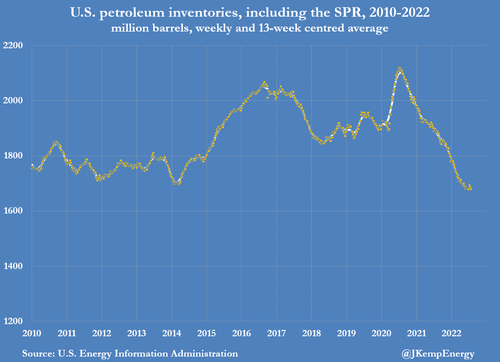Plunging US Oil Inventories Imply Deeper Slowdown Will Be Needed
By John Kemp, senior market analyst at Reuters
U.S. petroleum inventories are not rebuilding – despite record releases from the government’s strategic reserve and a slowdown in the economy which is weighing on fuel consumption by manufacturers and freight firms.
In the short term, pressure on inventories is bullish for oil prices. In the medium term, however, it implies a deeper and longer cyclical downturn will be needed later in 2022 and early 2023 to rebalance the market.
Total stocks, including the strategic petroleum reserve, have fallen in 80 of the last 108 weeks by a total of 438 million barrels since the start of July 2020, according to data from the U.S. Energy Information Administration (EIA).
As a result, combined stocks of crude and refined products are at their lowest for the time of year since prices spiked to record highs in 2008 and before that 2004 (“Weekly petroleum status report”, EIA, July 27).
Inventories have been broadly stable over the last 8-10 weeks, which implies production and consumption have moved closer to balance, after a long period of significant under-production lasting almost two years, but there has been no sign of them starting to rebuild to more comfortable levels.
In the most recent week, petroleum inventories depleted by 9 million barrels, with drawdowns in strategic crude reserves (-6 million), commercial crude (-5 million), gasoline (-3 million) and distillate fuel oil (-1 million), partially offset by builds in propane (+3 million) and other oils (+3 million).
Distillate fuel oil remains the tightest part of the market…
… with inventories at the lowest for the time of year since 2000, and before that 1996, and they show no signs of increasing.
Distillate stocks usually increase in the third quarter as refineries produce more diesel and heating oil as a by-product of processing more crude to meet summer driving season demand for gasoline.
But stocks have risen by less than 1 million barrels so far this quarter, one of the smallest increases in the last 40 years, pointing to a persistent shortage, which is unsustainable.
Stocks have risen by around 400,000 barrels since the end of June compared with an average pre-pandemic seasonal increase of 5.5 million barrels in the ten years between 2010 and 2019.
Distillate consumption is the most sensitive part of the fuel market to changes in the manufacturing and freight cycle.
Both manufacturing activity and freight have decelerated since the start of the year, easing some distillate demand and helping stabilise inventories.
But the extremely low level of inventories and their failure to rebuild implies a much deeper and longer economic slowdown will now be required to allow crude and especially fuel stocks to recover.
Tyler Durden
Thu, 07/28/2022 – 15:00

